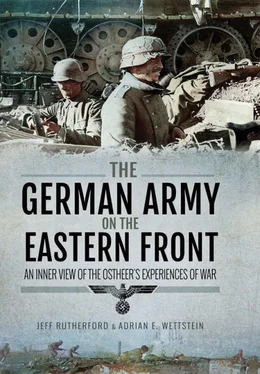2) [Panzer] Grenadier Regiments
a) Telephone communication
With the grenadier regiments, only wire connections from the regiments to the battalions can be built due to lack of personnel and equipment. When the regiments change position, it is not possible at to dismantle and at the same time to connect both battalions by wire again. In the event of a further loss of personnel, the telephone connections to the battalions will also be called into question.
b) Radio communication
An overlay of the telephone connections from the regiments to the battalions cannot be made at the moment. Radio connections to the companies can no longer be made due to the losses of the pack radio sets. The repair of the pack radio sets takes a very long time because of difficulty in obtaining spare parts, and often cannot be carried out. Frequently occurring malfunctions on the G device do not guarantee secure connections.
3) Reconnaissance battalion
At the moment, radio communication of the battalion is still ensured. Difficulties arise from the fact that the battalion has to take over the radio communications made by the tank signal battalion, i.e. from the divisional commander to the [reconnaissance] battalion, and from the [reconnaissance] battalion to the regiments instructed to cooperate. Due to a total failure of a radio station, the battalion had to send one radio station to the third company.
4) Tank battalion
Radio connection within the battalion is ensured. The only command vehicle is in need of repair, every day failure is expected. If this vehicle fails, the battalion is no longer connected to the division and to the supply trains. The remote station at the battalion cannot be set by the tank signal battalion, since it has no command tank.
5) Artillery
Telephone connections
At distances up to 3 kilometres from the regiment to the battalions and from the battalions to the batteries, the required telephone connections can still be ensured at the moment. If the battalions are positioned beyond these distances, the construction of the telephone connections to the battalions poses considerable difficulties due to lack of cable. Due to the failure of motor vehicles, the regiment can only make radio connections to one battalion. For the same reasons and through the loss of G-devices, the battalion cannot establish a radio connection to the deployed batteries. The equipment of the battalions was handed over to the batteries in order to ensure fire direction. There are great difficulties with the artillery support of the armoured group, since the regiment currently has only two armoured observation vehicles. The observer may therefore have to direct fire of several batteries at the same time, which runs into considerable radio-technical difficulties. As a result of a lack of personnel, the radio stations can only be occupied by one radio operator, and with his loss, the device also fails.

6) Engineer battalion
Of five pack radio sets, [20]two are still operational. Radio communication is therefore conditionally ensured.
7) Army anti-aircraft battalion
Telephone connections and radio communication are ensured. Due to the loss of electric generators (GG 400), difficulties arise in the field of the supply of power sources.
8) Anti-tank battalion
Radio communication to the division can no longer be established due to the losses of motor vehicles and equipment. An improvised establishment of a radio link to the deployed platoons can only be achieved with great difficulty. The radios are loaded on the self-propelled anti-tank guns, but since the space is used for the gun crew and ammunition, radioing is not possible in combat.
Overall vacancies of unit signal soldiers:
Total vacancies of the unit’s signal soldiers: 374 NCOs and men = in total 35%.
As this report notes, all of the division’s units suffered from a lack of both radio and telephone equipment. It should be kept in mind here that both radio and telephone communications are systems, which require several devices and expendable materials such as cable or storage batteries. A shortage of one device could hamper the whole system, as was the case with electric generators for the 8th Panzer Division. Shortages and a general lack of communications equipment did not allow all units to connect with each other or with higher and lower levels, not to mention having reserve lines or being able to back up telephone lines with radio communication. Furthermore, the lack of equipment reduced tactical flexibility, i.e. positioning batteries outside of a rather small area or the simultaneous dismantling and the construction of telephone lines for the Panzer Grenadier units. The lack of motor vehicles – as will be discussed in chapter 4, a problem that plagued the German army for most of the war in the east – reduced the troops’ mobility and did not allow them to carry much material. Especially problematic was the situation with armoured command or observation vehicles, as their scarcity made communication during attack difficult. The production of these special-purpose vehicles was always in competition with combat vehicles, as they drew from the same production resources. A final issue that can be seen from the report and was especially stressed in the artillery section was the lack of trained personnel. The shortage of adequately trained signal personnel led to higher losses in equipment due to careless use and poor maintenance, but also in longer interruptions in communication until deficiencies could be identified. For radio operators, ciphering was also an issue, and the frequency of openly sent messages increased as training standards declined.
To overcome shortages in communication equipment, and a lack of training at the lower leadership level, and also to influence the course of battles and operations, German commanders were often present at or near the front. By conferring with subordinates on the spot, they had a better understanding of the actual situation. Finally, the presence of divisional, corps and army commanders at the front line had a positive psychological effect on frontline troops. Even the commander of Sixth Army in 1942, General der Panzertruppen (later Generaloberst ) Friedrich Paulus, often ill-reputed as a ‘desktop general’, regularly visited his subordinates and troops. The so-called ‘front tours’ were documented and provide good insight into that part of command practice. This is the report of the front tour of 15 October 1942: [21]
Читать дальше














![John Stieber - Against the Odds - Survival on the Russian Front 1944-1945 [2nd Edition]](/books/405234/john-stieber-against-the-odds-survival-on-the-russian-front-1944-1945-2nd-edition-thumb.webp)





